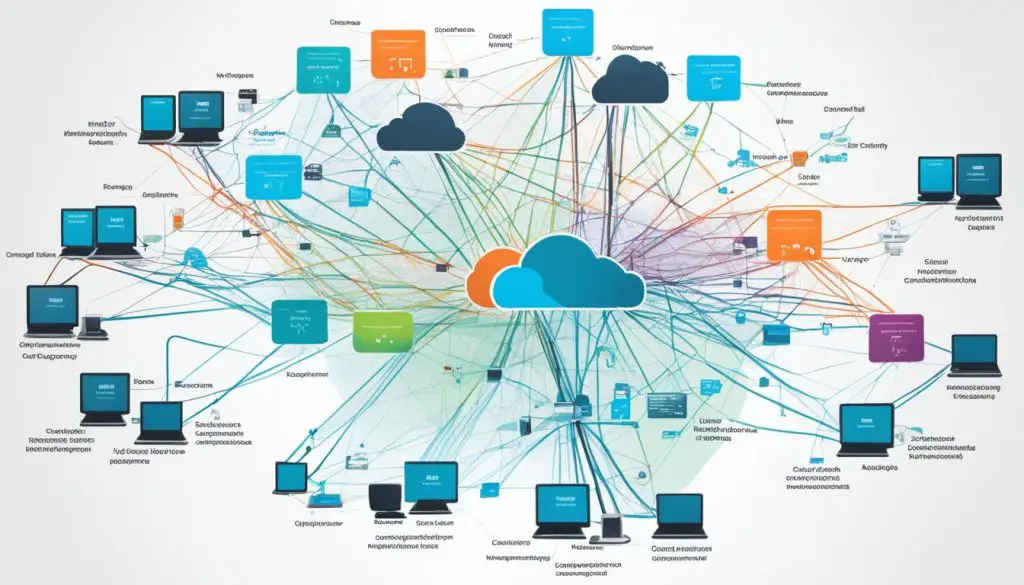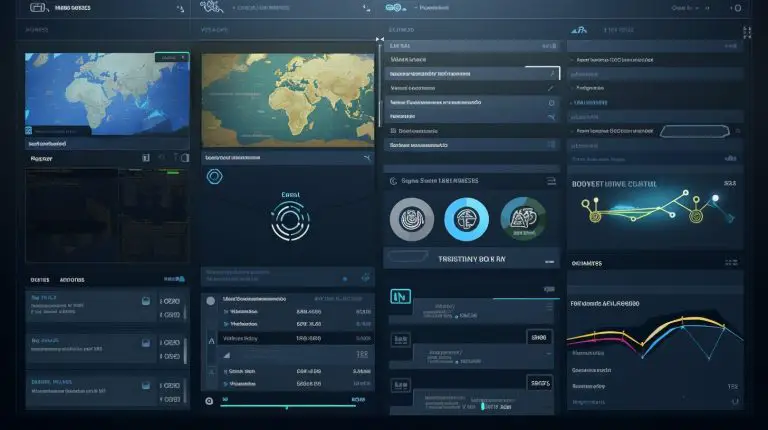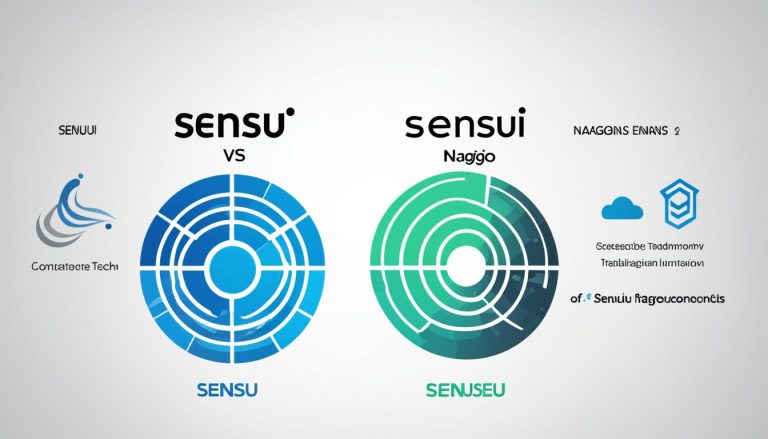Icinga vs. Sensu: A Detailed Monitoring Comparison
When it comes to monitoring your IT infrastructure, open-source monitoring tools provide a cost-effective and flexible solution. But with so many options available, how do you choose the right one for your organization? In this article, we will compare two popular monitoring tools – Icinga and Sensu – and delve into their features, pricing, user reviews, and more. So, which tool will come out on top in the battle of Icinga vs. Sensu? Let’s find out!
Key Takeaways:
- Icinga and Sensu are open-source monitoring tools for IT infrastructure monitoring.
- We will compare their features, pricing, user reviews, and deployment options.
- Consider your specific requirements and preferences when choosing the best monitoring software for your enterprise.
- Explore alternative monitoring tools alongside Icinga and Sensu.
- Understand the background and reputation of the companies behind the tools for better insights.
Pricing Comparison
When comparing monitoring tools like Icinga and Sensu, one crucial aspect to consider is their pricing models. Understanding the costs associated with these tools can help you make an informed decision that aligns both with your organization’s budget and the specific features you require. Let’s dive into a comparison of Icinga pricing and Sensu pricing to give you a better understanding of the cost of these monitoring solutions.
Icinga Pricing
Icinga offers a flexible pricing structure that caters to organizations of different sizes and needs. They provide both open-source and commercial versions, allowing users to choose the option that best suits their requirements. Icinga follows a subscription-based model for their commercial offering, with pricing tiers based on the number of hosts or devices to be monitored. To get detailed pricing information, you can visit the Icinga website.
Sensu Pricing
Similarly, Sensu provides various pricing options to accommodate different business requirements. Their pricing model is based on a subscription plan, with pricing tiers based on the number of check endpoints, which include hosts or devices to be monitored. Sensu offers a pricing calculator on their website, allowing users to estimate the cost based on their specific needs. This transparency in pricing helps organizations plan their monitoring budget effectively.
By comparing Icinga pricing and Sensu pricing, you can evaluate which monitoring tool aligns better with your budget and requirements. Consider factors such as the number of hosts/devices you need to monitor, the desired level of support, and the additional features provided by each tool. It’s essential to find a balance between cost and functionality to ensure you make a well-informed decision.
Next, we will delve into the key features of Icinga and Sensu to help you understand their functionalities better.
Key Features
When it comes to network and system monitoring, both Icinga and Sensu offer a wide range of robust features. Let’s take a closer look at what each tool brings to the table.
Icinga Features
Icinga provides an array of powerful features that make it a popular choice for monitoring IT infrastructure. One standout feature is its integrated cluster system, which allows for efficient monitoring of large-scale networks. Additionally, Icinga offers SSL security, ensuring the confidentiality and integrity of your monitoring data. The lightweight web interface provides a user-friendly experience, enabling seamless navigation and configuration.
Sensu Features
Sensu, on the other hand, focuses on dynamic infrastructure monitoring. It excels in providing functional role-based monitoring, allowing you to tailor monitoring tasks to specific roles within your organization. Connectivity monitoring is another standout feature, enabling you to monitor the availability and performance of network connections. Sensu also offers self-service developer APIs, empowering developers to integrate monitoring into their workflows seamlessly.
Whether you’re looking for integrated cluster systems and SSL security or dynamic infrastructure monitoring and connectivity monitoring, both Icinga and Sensu have the features to meet your network and system monitoring needs.
Continue reading to explore user reviews of these two monitoring tools and gain insights into the experiences of real users.
User Reviews
User reviews are valuable resources for evaluating monitoring tools and determining user satisfaction. Both Icinga and Sensu have garnered positive feedback from customers. However, it is essential to consider a variety of reviews to gain a comprehensive understanding of user experiences with these tools. Let’s take a closer look at what users have to say about Icinga and Sensu.
Icinga User Reviews
Customers using Icinga have expressed their satisfaction with the tool’s robust features and reliable performance. Users appreciate the integrated cluster system, which allows for seamless scalability and efficient management of monitoring infrastructure. Furthermore, the SSL security feature ensures that sensitive data remains protected, addressing the concerns of security-conscious enterprises. Icinga’s lightweight web interface also receives praise for its ease of use and accessibility.
“Icinga is a game-changer when it comes to monitoring our IT infrastructure. Its cluster system enables us to monitor multiple systems effortlessly. It’s easy to set up and has a user-friendly web interface that provides real-time updates on system health. The SSL security is a huge plus as it ensures the confidentiality of critical data.”
Sensu User Reviews
Sensu users have also expressed their satisfaction with the tool’s dynamic infrastructure monitoring capabilities. The functional role-based monitoring feature allows users to easily customize monitoring workflows based on their specific needs. Users also appreciate Sensu’s connectivity monitoring, which ensures the seamless functioning of critical network components. Furthermore, the self-service developer APIs provide flexibility for developers to integrate monitoring services into their workflows.
“Sensu has greatly improved our infrastructure monitoring process. Its dynamic monitoring capabilities are excellent, allowing us to adapt the monitoring configuration to our changing system requirements. The connectivity monitoring feature ensures that our network components are always up and running smoothly. The self-service developer APIs have also been very useful for integrating monitoring into our CI/CD pipelines.”
While these reviews provide valuable insight into the experiences of Icinga and Sensu users, it’s important to read more reviews to form a holistic view. Different organizations may have varying requirements and preferences, so it’s essential to consider multiple perspectives to make an informed decision.
Pros and Cons
Both Icinga and Sensu have their strengths and weaknesses that should be considered when evaluating the best monitoring tool for your enterprise needs. Let’s explore the advantages and disadvantages of each.
Icinga: Pros
- Integrated Cluster System: Icinga offers an integrated cluster system, allowing for efficient and scalable monitoring of distributed environments.
- Object-Based Configuration: With Icinga, you can configure monitoring objects, making it easier to manage and organize your monitoring setup.
Sensu: Pros
- Lightweight Framework: Sensu is praised for its lightweight framework, which minimizes resource usage and ensures efficient monitoring performance.
- Simple User Interface (UI): Sensu provides a simple and intuitive user interface, making it easier for users to navigate and configure monitoring settings.
While Icinga’s integrated cluster system and object-based configuration provide advantages for larger environments, Sensu’s lightweight framework and simple UI make it an attractive choice for organizations looking for a streamlined monitoring tool.
It’s important to consider these pros and cons when making a decision. Each tool has its own unique strengths that may align better with your specific monitoring needs.
Next, let’s dive deeper into the deployment and support options for Icinga and Sensu, as these factors can also greatly impact your decision-making process.
Deployment and Support
When it comes to deploying and supporting monitoring tools, Icinga and Sensu offer various options to cater to the diverse needs of organizations. Let’s explore the deployment options and support resources provided by both tools.
Deployment Options
Icinga and Sensu understand that each organization has its specific requirements, which is why they offer different deployment options to accommodate various infrastructures. For Icinga deployment, you have the choice of using preconfigured monitoring stacks that provide a streamlined setup process. This can save time and effort, especially for organizations that prefer a hassle-free implementation.
On the other hand, Sensu provides external perspectives for deployment. This flexibility allows organizations to integrate Sensu monitoring into their existing infrastructure seamlessly. Whether you have a complex network architecture or prefer specific customization options, Sensu’s deployment options can cater to your unique needs.
It’s essential to evaluate your organization’s existing infrastructure and consider the scalability and flexibility offered by each tool’s deployment options. This will ensure a smooth integration process and enhance your monitoring capabilities.
Support Options
Technical assistance and robust support resources are vital for maintaining a reliable monitoring system. Icinga and Sensu recognize this need and offer diverse support options to assist their users.
Icinga provides a range of support resources, including a community forum where users can exchange ideas, share experiences, and seek advice from fellow Icinga enthusiasts. Additionally, Icinga offers comprehensive documentation that covers various topics, including installation, configuration, and troubleshooting. This documentation serves as a valuable reference for users at all levels of expertise.
For organizations that require dedicated technical assistance, Icinga also offers paid support plans. These plans provide direct access to Icinga’s team of experts who can assist with complex issues, provide guidance, and ensure smooth operation of your monitoring infrastructure.
Similarly, Sensu offers a vibrant community ecosystem where users can engage with each other, ask questions, and receive support. The community forum provides a wealth of knowledge and collaborative problem-solving opportunities.
Additionally, Sensu’s comprehensive documentation helps users navigate the various features and functionalities of the tool. From installation guides to advanced configuration tips, the documentation serves as a valuable resource for users looking to maximize the potential of Sensu.
The Power of Technical Assistance
Both Icinga and Sensu recognize that some organizations may require additional technical assistance beyond the community resources and documentation. In such cases, they offer paid technical assistance services to provide dedicated support tailored to your organization’s specific needs.
Whether you need assistance with installation, configuration, or troubleshooting, the technical assistance teams of Icinga and Sensu are equipped to provide personalized support. Having this level of technical assistance ensures that you can rely on expert guidance, minimize downtime, and make the most of your monitoring tool.
Alternatives
While Icinga and Sensu are popular monitoring tools, they are not the only options available in the market. If you’re looking for alternatives to these tools, here are a few worth considering:
- PRTG: PRTG is a comprehensive network monitoring tool that offers features such as customizable dashboards, real-time alerts, and in-depth reporting. It supports various protocols and can monitor both on-premises and cloud-based environments.
- Site24x7: Site24x7 is a cloud-based monitoring solution that provides comprehensive insights into the performance and availability of your IT infrastructure and applications. It offers features like synthetic monitoring, real user monitoring, and automated root cause analysis.
- ManageEngine OpUtils: ManageEngine OpUtils is a network monitoring and management tool that helps you monitor your network devices, troubleshoot network issues, and perform network diagnostics. It offers a range of tools like IP address manager, switch port mapper, and Wake-on-LAN.
These are just a few examples of the many monitoring tools available in the market. Take the time to research and compare these alternatives to find the best monitoring software that suits your specific needs.
Company Details
Understanding the background and history of the companies behind Icinga and Sensu is essential when considering these open-source monitoring tools for your IT infrastructure. Let’s delve into the company profiles and gather some valuable insights:
Icinga Company Details
Established in 2009, Icinga is a renowned player in the monitoring software industry. Their mission is to provide robust and reliable monitoring solutions for enterprises worldwide. With a strong focus on open-source development, Icinga has gained a reputation for delivering innovative features and excellent performance.
In addition to offering a comprehensive monitoring platform, Icinga is committed to fostering a vibrant community of users and contributors. This collaborative approach ensures continuous product enhancements and a diverse range of plugins and add-ons to meet specific monitoring needs. Their dedication to customer support and engagement further solidifies their position as a trusted monitoring solution provider.
Sensu Company Details
Sensu, established in 2011, has quickly become a prominent name in the IT monitoring landscape. Their mission is to help organizations optimize their operational workflows through their performance monitoring platform. Sensu takes pride in their ability to provide solutions that are both powerful and easy to use.
As an open-source project, Sensu values community contributions and believes in the collective intelligence of its users. Their commitment to fostering an inclusive and supportive community has resulted in a wide variety of community-driven plugins and resources that enhance the functionality of their monitoring tools.
“At Sensu, we empower organizations to achieve operational excellence by providing them with the tools they need to scale efficiently, detect anomalies proactively, and automate remediation effectively.”
Both Icinga and Sensu have a strong presence in the monitoring software industry, offering feature-rich solutions and prioritizing customer satisfaction. Now, let’s continue our comparison and uncover more insights about these powerful monitoring tools.

Icinga vs. Sensu: A Comparison
Now it’s time to dive into the detailed comparison between Icinga and Sensu. We will explore their key features, pricing models, user reviews, and deployment options. This comparison will help you make an informed decision about which monitoring tool best fits your enterprise needs.
Key Features
When comparing Icinga and Sensu, it’s important to consider their key features. Icinga provides a comprehensive set of network and system monitoring capabilities. It offers an integrated cluster system, SSL security, and a lightweight web interface that allows for easy management and monitoring.
Sensu, on the other hand, focuses on dynamic infrastructure monitoring. It excels in functional role-based monitoring, connectivity monitoring, and provides self-service developer APIs for maximum flexibility and customization.
Pricing Models
When it comes to pricing, both Icinga and Sensu offer different models to suit various budgets. It’s essential to assess your organization’s requirements and budgetary constraints to determine the most cost-effective option.
Icinga provides transparent pricing information on its website, allowing you to choose the plan that best suits your needs. Sensu follows a similar approach with flexible pricing options tailored to your specific requirements.
User Reviews
Learning from the experience of others is valuable in evaluating monitoring tools. Both Icinga and Sensu have received positive feedback from users. Taking the time to explore user reviews will give you a well-rounded understanding of the strengths and weaknesses of each tool.
Deployment Options
The deployment options offered by Icinga and Sensu may influence your decision-making process. Icinga provides preconfigured monitoring stacks and external perspectives for easy deployment. Sensu also offers various deployment options, ensuring a seamless integration into your existing infrastructure.
“I have been using Icinga for several years now, and it has become an indispensable tool for monitoring our network and systems. The cluster system and SSL security provide peace of mind, and the lightweight web interface is intuitive and user-friendly.”
“Sensu has been a game-changer for our organization. The dynamic infrastructure monitoring and functional role-based monitoring have helped us identify and resolve issues quickly. The self-service developer APIs are also a great feature.”
By considering the key features, pricing models, user reviews, and deployment options of Icinga and Sensu, you can make an informed decision about which monitoring tool is the best fit for your enterprise needs.
Conclusion
After carefully evaluating the pros and cons, comparing the key features and pricing models, and taking into account user reviews and deployment options, it is clear that deciding between Icinga and Sensu comes down to your specific requirements and preferences. Both monitoring tools offer robust capabilities for network and system monitoring, with Icinga excelling in its integrated cluster system and object-based configuration, while Sensu stands out for its lightweight framework and simple UI.
Ultimately, the best monitoring software for enterprises will depend on your organization’s unique needs and goals. Consider the factors discussed in this article when making your decision. Take into account factors such as your IT infrastructure size and complexity, budget constraints, desired level of customization, and the level of technical expertise available within your team.
By carefully analyzing these factors, you will be able to determine which monitoring software – Icinga or Sensu – is the right fit for your enterprise. Remember to also explore other alternatives in the market to ensure you make an informed choice. Choose the monitoring solution that provides the most effective performance monitoring platforms, alerting and notifications, and meets all of your specific business requirements. With the right monitoring software in place, you can proactively manage and maintain a healthy IT infrastructure.
FAQ
What are some key features of Icinga and Sensu?
How do I determine the pricing of Icinga and Sensu?
What kind of deployment options do Icinga and Sensu offer?
What support options are available for Icinga and Sensu?
Can you recommend any alternatives to Icinga and Sensu?
What do user reviews say about Icinga and Sensu?
What are the pros and cons of using Icinga and Sensu?
Where can I find company details for Icinga and Sensu?
How does Icinga compare to Sensu in terms of features and performance?
What is the best monitoring software for enterprises?
- About the Author
- Latest Posts
Mark is a senior content editor at Text-Center.com and has more than 20 years of experience with linux and windows operating systems. He also writes for Biteno.com




